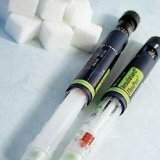Metabolic disorders in diabetes mellitus
 Today we will consider metabolic disorders in diabetes mellitus and management of patients with this disease. Doing
Today we will consider metabolic disorders in diabetes mellitus and management of patients with this disease. Doing
diabetics second type is difficult Diabetology current clinical heterogeneity due to disease and the need for selection of various hypoglycemic agents, taking into account the optimum effect for the main units of the second type diabetes pathology. If we talk about
metabolic disorders , is another important component of the treatment of patients with non-insulin dependent diabetes is the correction of disturbances of lipid metabolism, and control of hypertension, which is often accompanied by a deterioration of the metabolism of carbohydrates, in 25-45% of situations are precursors to the development of hyperglycemia. Deterioration of lipid metabolism and arterial hypertension are risk factors for the development of the disease.
Today, as amended with respect to diagnostic criteria, and according to studies UKPDS , provided, rather, a more stringent requirements for the target values of glycemia in the case of ill treatment of diabetes type 2.For example, in accordance with the recommendations of the European expert group developing policy reference diseased CD, best considered to be the level of fasting glucose( 6 mmol / l, glycated HbA1c hemoglobin( 6, 5%).
Question concerning causal relationship glycemia and increase the risk of macroAnd microvascular complications has found its clinical expression with respect to the level of compensation of carbohydrate metabolism and the frequency of chronic complications of diabetes. According to the results of UKPDS, one can conclude how much the risk of growth of pathologistsand vessels when the rate of glycated hemoglobin by only 1%. As a result, the most important task in the case of clinicians assumed early detection of deterioration in carbohydrate metabolism and correct intensive medical management of the patient strategy with diabetes.
diabetes treatment.
Effective treatment of diabetes of the second type can not be carried out. disregarding its growth characteristics Pathogenetic basis of growth of non-insulin diabetes includes, on the one hand, insulin resistance, and the other - the deterioration of insulin secretion via b -cells of the pancreas. The deterioration of insulin secretion in the early stages is evident from the insufficiency of the first phase of insulin secretion with the following decrease in secretory activity, as a response to the stimulation by glucose of b cells.
Overweight, android or visceral obesity can be considered the most important components of the insulin resistance syndrome. Visceral fever is characterized by reduced sensitivity to the anti-political influence of insulin, which leads to lipolysis activity with the formation of a large number of free fatty acids( FFA).
In connection with the developed insulin resistance of muscles, its ability to utilize glucose decreases, as a result of which hyperglycemia increases in combination with compensatory hyperinsulinemia. FFAs resist the natural process of insulin binding to hepatocytes, which is reflected in the inhibitory effect of the latter on the production of glucose by the liver.
Recently, there have been studies emphasizing the role in the development and progress of vascular pathology of postprandial hyperglycemia. It has been shown that post-prandial growth of glycemia seriously affects the risk of increasing complications of diabetes than fasting hyperglycaemia.
It has long been known that among patients who have diabetes mellitus and among doctors themselves there is a specific standard in relation to the control of fasting glycemia only, whereas the duration of postprandial state over time is significantly higher than the fasting state.
In reality, the condition on an empty stomach comes after a period of absorption or a postabsorption cycle, the duration of which is approximately 6 hours after the last meal. Taking into account a minimum of three meals a day of persons without deterioration of carbohydrate metabolism with a 4-hour duration of each such period, the duration of the whole post-prandial phase in general is at least 12 hours. Other 12 hours are distributed between the fasting phase and the postabsorption period. Given the duration of each period equal to 6 hours, we can talk about the overlapping postabsorption and postprandial periods in the afternoon, and for the fasting phase, taking into account the last meal at 19:00, it takes about 4 hours. In patients with type 2 diabetes, the postprandial increase in glycemia is significantly more pronounced, more prolonged, and differs significantly in comparison with healthy individuals. As a result, for the management of diabetes, the definition and normalization of glycemic levels after eating is as important as determining fasting blood sugar.
Two main approaches in the treatment of patients with diabetes 2 types are based on the principles: the traditional approach of , which is focused on the tactics of sequential prescribing of sugar-lowering drugs; is an intensive technique of , aimed at achieving glycemic targets.
When we talk about type 2 diabetes, the conservative therapy is aimed at eliminating the symptoms that are associated with an increased level of glycemia. At the starting point, monotherapy is prescribed with the help of a diet. Then, when the patient has active hyperglycemia symptoms, a specific sugar-lowering drug is added to the treatment. It should also be noted that the achievement of normoglycemia only on diet therapy is possible in an absolute minority of patients. Thus, in studies, the effectiveness of diet therapy was confirmed only in the case of 45% of patients with newly diagnosed type 2 diabetes during the first six years from the onset of the disease, and less than in the case of 20%, after 12 years.
Intensive therapy strategy is focused on achieving the required glycemic parameters. Often, therapy is carried out using a combination of sugar-lowering drugs that affect certain links in the pathology of type 2 diabetes.



